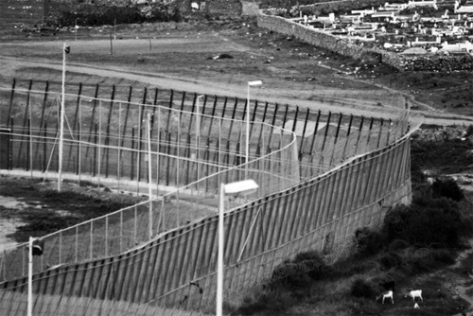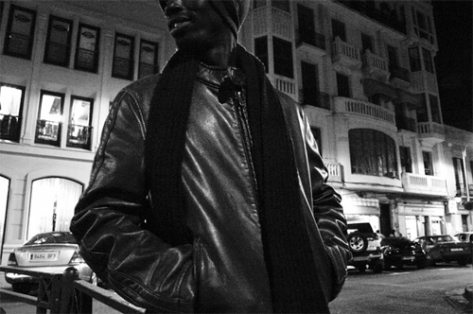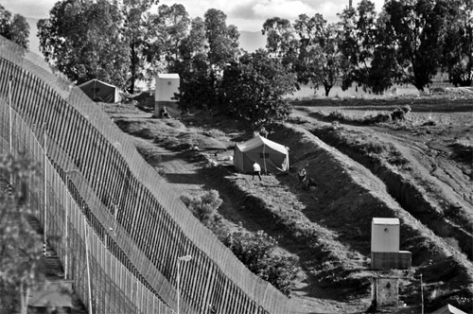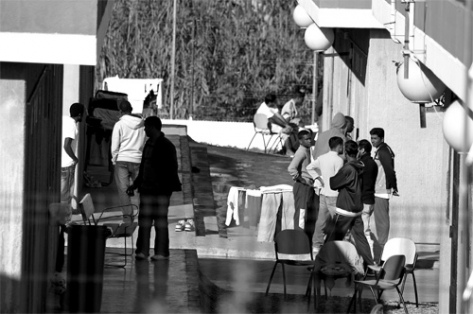DominionSections
Browse Articles
- IndependentMedia.ca
- MostlyWater.org
- Seven Oaks
- BASICS Newsletter
- Siafu
- Briarpatch Magazine
- The Leveller
- Groundwire
- Redwire Magazine
- Canadian Dimension
- CKDU News Collective
- Common Ground
- Shunpiking Magazine
- The Real News
- Our Times
- À babord !
- Blackfly Magazine
- Guerilla News Network
- The Other Side
- The Sunday Independent
- Vive le Canada
- Elements
- ACTivist Magazine
- The Tyee
- TML Daily
- New Socialist
- Relay (Socialist Project)
- Socialist Worker
- Socialist Action
- Rabble.ca
- Straight Goods
- Alternatives Journal
- This Magazine
- Dialogue Magazine
- Orato
- Rebel Youth
- NB Media Co-op
Radio
Fortress Europe
March 6, 2008
Fortress Europe
The Spanish/Moroccan Border
 Spanish/Moroccan border fence Photo: K. Flo Razowsky
Spanish/Moroccan border fence Photo: K. Flo Razowsky

As the gap between rich and poor widens around the world, those in the so-called Third World are desperate to reach the countries where food, jobs and ‘security’ remain. Similar to the US/Mexico border that is slowly being sealed off to those from the south, Fortress Europe is working hard to close itself off from those on the ‘outside.’
This essay is part of a larger project focused on borders that are becoming increasingly militarized and deadly, and the people and land they are dividing. These shots were taken from Melilla, Spain, a Spanish enclave in the north of Morocco. Migrants travel for four, five, sometimes six years to reach this side of the line, only to be held in migrant holding centres, sometimes for years, awaiting their papers or a deportation order back to where they started.
 The border fence consists of 11 kilometres of parallel three-metre-high fences topped with barbed wire and regular watch-posts, with a road running in between to accommodate police patrols.
The border fence consists of 11 kilometres of parallel three-metre-high fences topped with barbed wire and regular watch-posts, with a road running in between to accommodate police patrols. If a migrant succeeds in scaling the first section of the border fence, he/she lands on a mess of razor-wire rods designed to inflict injury.
If a migrant succeeds in scaling the first section of the border fence, he/she lands on a mess of razor-wire rods designed to inflict injury.  CETI (Immigrants' Temporary Holding Centre). Although official EU documents states that the "stay in the centres should be for up to three months," many migrants have been living in this centre for up to two years.
CETI (Immigrants' Temporary Holding Centre). Although official EU documents states that the "stay in the centres should be for up to three months," many migrants have been living in this centre for up to two years.  Migrants living at the CETI detention centre in Melilla, Spain, often work 12 hours a day washing and parking cars for spare change.
Migrants living at the CETI detention centre in Melilla, Spain, often work 12 hours a day washing and parking cars for spare change. A few of the Moroccan youth that live in a detention centre in Melilla, Spain, hoping to get Spanish papers.
A few of the Moroccan youth that live in a detention centre in Melilla, Spain, hoping to get Spanish papers. Bangladeshi migrants in a camp they built outside the CETI detention centre in order to elude the immigration police who come to CETI in the night and take them from their beds for deportation.
Bangladeshi migrants in a camp they built outside the CETI detention centre in order to elude the immigration police who come to CETI in the night and take them from their beds for deportation. Along the border fence, underground cables connect spotlights, noise and movement sensors, and video cameras to a central control booth.
Along the border fence, underground cables connect spotlights, noise and movement sensors, and video cameras to a central control booth.
This migrant from Cote d'Ivoire, is one of the two sole survivors of a group of nine that originally set off to migrate north. The seven died at different points while crossing the desert by foot and the sea by boat. This man has now lived at CETI for almost a year waiting either for papers or rejection and deportation. The other survivor still has not made it to European soil. The story is not an uncommon one.
 The border fence with a view of the Moroccan troops guarding the other side. Since 2005, repressive measures to secure this border have been put into the hands of the Moroccan authorities in order to leave the Spanish (ie, European) authorities free from human rights violations.
The border fence with a view of the Moroccan troops guarding the other side. Since 2005, repressive measures to secure this border have been put into the hands of the Moroccan authorities in order to leave the Spanish (ie, European) authorities free from human rights violations. Migrants from Africa play checkers on a homemade board to pass the time. Migrants spend anywhere from a couple of months to a couple of years living in this CETI detention centre awaiting either papers or deportation.
Migrants from Africa play checkers on a homemade board to pass the time. Migrants spend anywhere from a couple of months to a couple of years living in this CETI detention centre awaiting either papers or deportation.
Late at night, these migrants from Bangladesh move en masse to their 'other camp' in order to avoid the night time immigration police raids.

Tents have been brought in to solve the problem of overcrowding at the centre, which reaches triple capacity at times. The tents are low quality and leave many, like these Algerian migrants, flooded out after a rain.
 In the Bangladesh 'other camp.' It is common for these men to have spent up to four years travelling to this side of the border and almost two years waiting in the CETI detention camp for either papers or deportation. The majority of the men detained at CETI are under the age of 25.
In the Bangladesh 'other camp.' It is common for these men to have spent up to four years travelling to this side of the border and almost two years waiting in the CETI detention camp for either papers or deportation. The majority of the men detained at CETI are under the age of 25.Related articles:
By the same author:
Comments
Archived Site
The Dominion is a monthly paper published by an incipient network of independent journalists in Canada. It aims to provide accurate, critical coverage that is accountable to its readers and the subjects it tackles. Taking its name from Canada's official status as both a colony and a colonial force, the Dominion examines politics, culture and daily life with a view to understanding the exercise of power.

